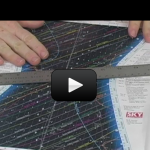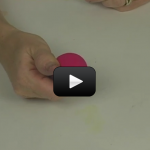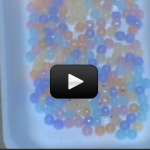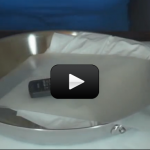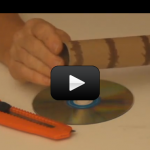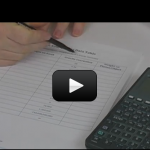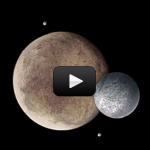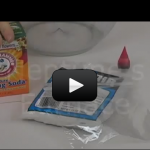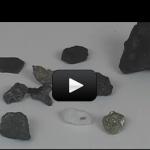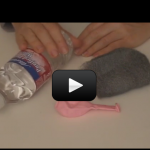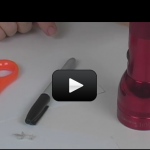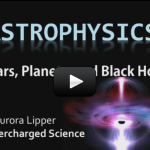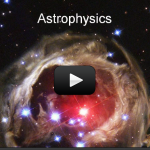What’s Up in the Sky?
Today you get to learn how to read an astronomical chart to find out when the Sun sets, when twilight ends, which planets are visible, when the next full moon occurs, and much more. This is an excellent way to impress your friends. The patterns of stars and planets stay the same, although they appear … Continue reading "What’s Up in the Sky?" |
Star Wobble
How do astronomers find planets around distant stars? If you look at a star through binoculars or a telescope, you’ll quickly notice how bright the star is, and how difficult it is to see anything other than the star, especially a small planet that doesn’t generate any light of its own! Astronomers look for a … Continue reading "Star Wobble" |
Fun with UV
UV (ultra-violet) light is invisible, which means you need more than your naked eyeball to do experiments with it. Our sun gives off light in the UV. Too much exposure to the sun and you’ll get a sunburn from the UV rays. There are many different experiments you can do with UV detecting materials, such … Continue reading "Fun with UV" |
How to “See” Infra-Red Light
Crazy Remote Want to have some quick science fun with your TV remote? Then try this experiment next time you flip on the tube: Materials: metal frying pan or cookie sheet TV remote control plastic sheet |
Sundial
Using the position of the Sun, you can tell what time it us by making one of these sundials. The Sun will cast a shadow onto a surface marked with the hours, and the time-telling gnomon edge will align with the proper time. In general, sundials are susceptible to different kinds of errors. If the … Continue reading "Sundial" |
Spectrometer
Spectrometers are used in chemistry and astronomy to measure light. In astronomy, we can find out about distant stars without ever traveling to them, because we can split the incoming light from the stars into their colors (or energies) and “read” what they are made up of (what gases they are burning) and thus determine … Continue reading "Spectrometer" |
Watch Your Weight
If you could stand on the Sun without being roasted, how much would you weigh? The gravitational pull is different for different objects. Let’s find out which celestial object you’d crack the pavement on, and which your lightweight toes would have to be careful about jumping on in case you leapt off the planet. Weight … Continue reading "Watch Your Weight" |
Binary Planetary Systems
A binary system exists when objects approach each other in size (and gravitational fields), the common point they rotate around (called the center of mass) lies outside both objects and they orbit around each other. Astronomers have found binary planets, binary stars, and even binary black holes. The path of a planet around the Sun … Continue reading "Binary Planetary Systems" |
Neptune’s Furnace
We’re going to do a chemistry experiment to simulate the heat generated by the internal core of Neptune by using a substance used for melting snow mixed with baking soda. Calcium chloride splits into calcium ions and chloride ions when it is mixed with water, and energy is released in the form of heat. The … Continue reading "Neptune’s Furnace" |
Meteorites
A meteoroid is a small rock that zooms around outer space. When the meteoroid zips into the Earth’s atmosphere, it’s now called a meteor or “shooting star”. If the rock doesn’t vaporize en route, it’s called a meteorite as soon as it whacks into the ground. The word meteor comes from the Greek word for … Continue reading "Meteorites" |
Rusty Balloon
Mars is coated with iron oxide, which not only covers the surface but is also present in the rocks made by the volcanoes on Mars. Today you get to perform a chemistry experiment that investigates the different kinds of rust and shows that given the right conditions, anything containing iron will eventually break down and … Continue reading "Rusty Balloon" |
Eclipses and Transits
It just so happens that the Sun’s diameter is about 400 times larger than the Moon, but the Moon is 400 times closer than the Sun. This makes the Sun and Moon appear to be about the same size in the sky as viewed from Earth. This is also why the eclipse thing is such … Continue reading "Eclipses and Transits" |
Atmospheres
Scientists do experiments here on Earth to better understand the physics of distant worlds. We’re going to simulate the different atmospheres and take data based on the model we use. Each planet has its own unique atmospheric conditions. Mars and Mercury have very thin atmospheres, while Earth has a decent atmosphere (as least, we like to … Continue reading "Atmospheres" |
Special Science Teleclass: Astronomy
This is a recording of a recent live teleclass I did with thousands of kids from all over the world. I've included it here so you can participate and learn, too Our solar system includes rocky terrestrial planets (Mercury, Venus, Earth, and Mars), gas giants (Jupiter and Saturn), ice giants (Uranus and Neptune), and assorted … Continue reading "Special Science Teleclass: Astronomy" |
Sundial
Using the position of the Sun, you can tell what time it us by making one of these sundials. The Sun will cast a shadow onto a surface marked with the hours, and the time-telling gnomon edge will align with the proper time. In general, sundials are susceptible to different kinds of errors. If the … Continue reading "Sundial" |
Atmospheres
Scientists do experiments here on Earth to better understand the physics of distant worlds. We’re going to simulate the different atmospheres and take data based on the model we use. Each planet has its own unique atmospheric conditions. Mars and Mercury have very thin atmospheres, while Earth has a decent atmosphere (as least, we like to … Continue reading "Atmospheres" |
Star Wobble
How do astronomers find planets around distant stars? If you look at a star through binoculars or a telescope, you’ll quickly notice how bright the star is, and how difficult it is to see anything other than the star, especially a small planet that doesn’t generate any light of its own! Astronomers look for a … Continue reading "Star Wobble" |
Eclipses and Transits
It just so happens that the Sun’s diameter is about 400 times larger than the Moon, but the Moon is 400 times closer than the Sun. This makes the Sun and Moon appear to be about the same size in the sky as viewed from Earth. This is also why the eclipse thing is such … Continue reading "Eclipses and Transits" |
Meteorites
A meteoroid is a small rock that zooms around outer space. When the meteoroid zips into the Earth’s atmosphere, it’s now called a meteor or “shooting star”. If the rock doesn’t vaporize en route, it’s called a meteorite as soon as it whacks into the ground. |
Binary Planetary Systems
A binary system exists when objects approach each other in size (and gravitational fields), the common point they rotate around (called the center of mass) lies outside both objects and they orbit around each other. Astronomers have found binary planets, binary stars, and even binary black holes. The path of a planet around the Sun … Continue reading "Binary Planetary Systems" |
Watch Your Weight
If you could stand on the Sun without being roasted, how much would you weigh? The gravitational pull is different for different objects. Let’s find out which celestial object you’d crack the pavement on, and which your lightweight toes would have to be careful about jumping on in case you leapt off the planet. Weight … Continue reading "Watch Your Weight" |
Neptune’s Furnace
We’re going to do a chemistry experiment to simulate the heat generated by the internal core of Neptune by using a substance used for melting snow mixed with baking soda. Calcium chloride splits into calcium ions and chloride ions when it is mixed with water, and energy is released in the form of heat. The … Continue reading "Neptune’s Furnace" |
Planetarium and Star Show
Greetings and welcome to the study of astronomy! This first lesson is simply to get you excited and interested in astronomy so you can decide what it is that you want to learn about astronomy later on. We’re going to cover a lot in this presentation, including: the Sun, an average star, is the central … Continue reading "Planetarium and Star Show" |
How to “See” Infra-Red Light
Crazy Remote Want to have some quick science fun with your TV remote? Then try this experiment next time you flip on the tube: Materials: metal frying pan or cookie sheet TV remote control plastic sheet |
Spectrometer
Spectrometers are used in chemistry and astronomy to measure light. In astronomy, we can find out about distant stars without ever traveling to them, because we can split the incoming light from the stars into their colors (or energies) and “read” what they are made up of (what gases they are burning) and thus determine … Continue reading "Spectrometer" |
Fun with UV
UV (ultra-violet) light is invisible, which means you need more than your naked eyeball to do experiments with it. Our sun gives off light in the UV. Too much exposure to the sun and you’ll get a sunburn from the UV rays. There are many different experiments you can do with UV detecting materials, such … Continue reading "Fun with UV" |
Rusty Balloon
Mars is coated with iron oxide, which not only covers the surface but is also present in the rocks made by the volcanoes on Mars. Today you get to perform a chemistry experiment that investigates the different kinds of rust and shows that given the right conditions, anything containing iron will eventually break down and … Continue reading "Rusty Balloon" |

